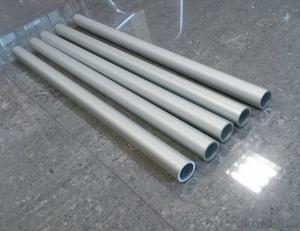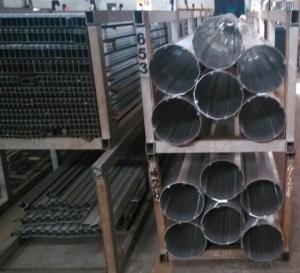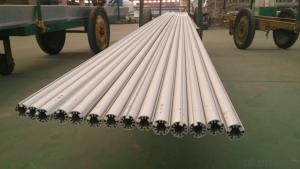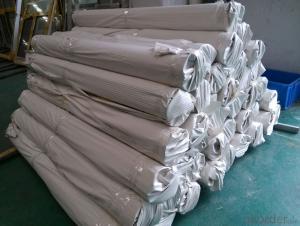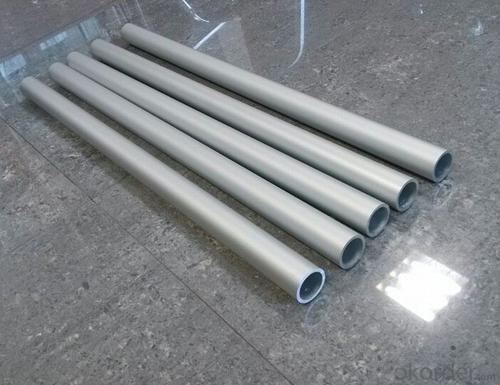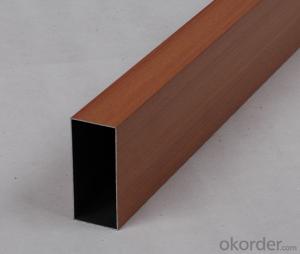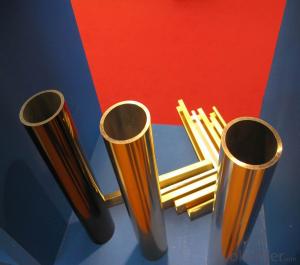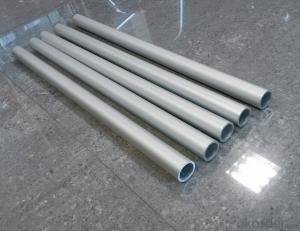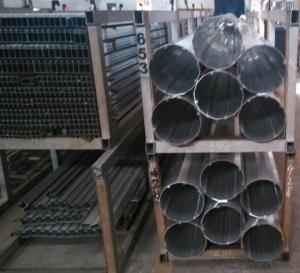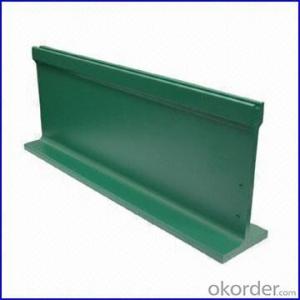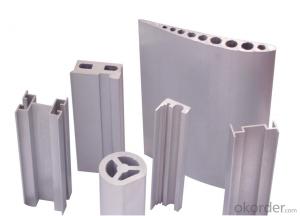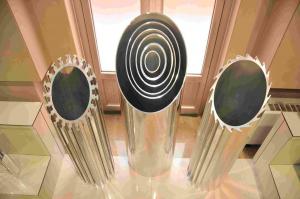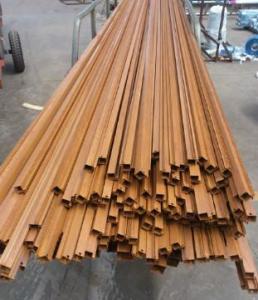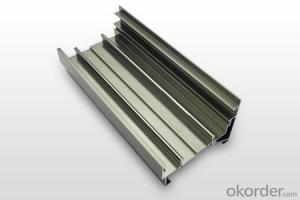Aluminum Extrusion Triangle Profiles for Furniture - Aluminium Round Tubes/Pipes
- Loading Port:
- Shanghai
- Payment Terms:
- TT OR LC
- Min Order Qty:
- 5 m.t.
- Supply Capability:
- 1000 m.t./month
OKorder Service Pledge
OKorder Financial Service
You Might Also Like
Specifications
1) Products: Round pipe, square pipe, flat pipe, special designed pipe
2) Grade: 1050,3003,5052,5083,6005,6061,6063,6082 etc.
3) WT:0.3mm above
4) OD: up to 550mm
5) Length: per customer's request
6) Process: heat extrusion, welding, seamless
Square industrial aluminium tube
1. Tolerance of frame thickness: +/-0.1-0.25mm.
2. Alloy & temper: Grade 6000 Series, T4-T6
3. Thickness: 1.0mm or according to customer’s requirements.
4. Max. Length: 6.0m, export length for 20" Container: 5.8m.
Round industrial aluminium tube
1. Tolerance of frame thickness: +/-0.1~0.25mm.
2. Alloy & temper: 6063-T5, Grade 6000 Series.
3. Thickness: 1.0mm , according to customer’s requirements.
4. Diameter: 2.5mm or according to customer’s requirements.
5. Max. Length:6m, export length for 20" Container: 5.8m.
Alloy | Si | Mg | Fe | Cu | Mn | Zn | Cr | Ti |
1050 | 0.25 | 0.05 | <0.40 | <0.05 | <0.05 | <0.05 | - | <0.03 |
3003 | 0.6 | 0.7 | 0.05 -0.20 | 1.0-1.5 | 0.10 | - | ||
5052 | 0.25 | 2.2-2.8 | 0.4 | 0.1 | 0.1 | 0.10 | 0.15-0.35 | - |
5083 | 0.4 | 4.0-4.9 | 0.4 | 0.1 | 0.4-1.0 | 0.25 | 0.05-0.25 | 0.15 |
6005 | 0.6-0.9 | 0.4-0.6 | <0.35 | <0.1 | <0.1 | <0.1 | <0.1 | <0.1 |
6061 | 0.4-0.8 | 0.8-1.2 | <0.70 | 0.15-0.4 | <0.15 | <0.25 | 0.04-0.35 | <0.05 |
6063 | 0.2-0.6 | 0.45-0.9 | <0.35 | <0.1 | <0.1 | <0.1 | <0.1 | <0.1 |
6082 | 0.7-1.3 | 0.6-1.2 | <0.50 | <0.1 | 0.4-1.0 | <0.2 | <0.25 | <0.10 |
| Alloy | NO | Temper | Out Side diameter(mm) | Thickness (mm) | Length (mm) |
| 1XXX | 1060,1100,1070A,1050A,1035,1200 | O,H112,H14,H18,F | 6-550(Max) | >=0.4 | 10-12000 |
| 2xxx | 2A11,2A12,2014,2024,2007 | O,T4,T42,T6,T62 | 6-550(Max) | >=0.4 | 10-12000 |
| 3xxx | 3003,3A21 | O,H12,H14,H16,H18,F | 6-550(Max) | >=0.4 | 10-12000 |
| 5xxx | ,5052,5083,5154,5450 | O,H32,H34,H36,H38,F | 6-550(Max) | >=0.4 | 10-12000 |
| 6xxx | ,6061,6063,6082 | O,T4,T42,T6,T62,T83,T831 | 6-550(Max) | >=0.4 | 10-12000 |
| 7xxx | 7A04,7A09,7075 | 0,T6,T62,T73 | 6-550(Max) | >=0.4 | 10-12000 |
Surface treatments :
1) Anodizing
2) Polishing
3) Powder coated
4) Electrophoresis
5) Sand-blast
6) Coating film
etc
Applications :
1) Micro-motors
2) Cylinder machines without wearing sleeve
3) Pneumatic cylinder
4) Heat transfer equipment
5) Construction industry
6) Curtain track
7) Structure support
8) Irrigation pipes
9) Furniture
- Q: how to determine its value? After these scrap to foundry on the 30...Emergency: the scrap aluminum production enterprises how to conduct accounting treatment, how to determine its value? After the aluminum foundry to exchange into ingots, to pay the processing fee to enter
- The cost of scrap is usually included in the cost of the product. Therefore, the sale of scrap, only income, there is no cost. If the need for management, the establishment of "raw materials - Waste - XXX" can also be. Examples are as follows:1, March 5th workshop in accordance with product production needs. Lead aluminum 1000kg, the unit price is 23.4567 yuanBorrow: production cost - direct material 23456.70Credit: raw materials, -XX profiles, 1000kg 23456.702 and March 25th, the waste generated by the workshop 20kg into the waste warehouse, according to the market price of 5 yuan /kg valuation, according to retire the library for accounting treatmentBorrowing: production costs - direct material -100Credit: raw materials - Scrap - profiles -20kg, -1003 and March 27th, the stock 1200kg scrap sent to the foundry for aluminum ingot, ingot factory price 6 yuan /kgBy: accounts receivable - foundries 7200Credit: other business income + tax 72004, March 27th, scrap exchange aluminum ingot 1050kg, unit price 8 yuan /kg, separately pay processing fee 1200 yuanBorrow: raw material - aluminium ingot 10508400Credit: accounts receivable - foundries 7200Accounts payable - foundries 1200Payment of processing fees (differentials)By: accounts payable 1200Cash: 1200
- Q: How do aluminum profiles perform in terms of weather resistance?
- Aluminum profiles exhibit remarkable weather resistance due to the unique qualities of aluminum itself, such as its resistance to corrosion and ability to endure harsh environmental conditions. To enhance their weather resistance, aluminum profiles are typically coated or anodized, providing long-lasting durability and protection against different weather elements. The corrosion resistance of aluminum is especially advantageous for outdoor applications. When exposed to oxygen, aluminum naturally forms an oxide layer, serving as a protective barrier against rust and deterioration. Consequently, aluminum profiles are highly resistant to moisture, rain, and humidity, making them suitable for use in coastal areas or regions with high levels of precipitation. Moreover, aluminum profiles also possess resistance against UV radiation. The application of surface treatments, such as powder coating or anodizing, adds an extra layer of defense against the sun's harsh rays. Consequently, aluminum profiles do not fade, chip, or crack when exposed to prolonged sunlight, ensuring their original appearance and structural integrity are preserved over time. Concerning extreme weather conditions, aluminum profiles are specifically designed to withstand high winds, extreme temperatures, and even severe storms. They possess excellent mechanical properties, including high strength and stiffness, enabling them to bear heavy loads and resist deformation. As a result, aluminum profiles are ideal for applications in construction, architecture, and outdoor infrastructure projects where weather resistance is of utmost importance. In conclusion, aluminum profiles exhibit exceptional weather resistance. Their inherent corrosion resistance, combined with the availability of various surface treatments, ensures their ability to endure a wide range of weather conditions while maintaining their structural integrity and aesthetic appeal.
- Q: Is it possible to recycle aluminum profiles and repurpose them for construction purposes?
- <p>Yes, aluminum profiles can be recycled and reused as building materials. Aluminum is highly recyclable, and the recycling process requires significantly less energy compared to producing new aluminum from raw materials. Recycled aluminum maintains its strength and properties, making it suitable for various construction applications. This practice not only conserves natural resources but also reduces waste and environmental impact.</p>
- Q: This question asks for the standard specifications and measurements of aluminum profiles that are frequently utilized in construction projects.
- <p>Aluminum profiles used in construction come in various specifications and measurements. Commonly, they are categorized by series such as 6060, 6061, 6063, and 6082, each with different mechanical properties. Sizes can range from small profiles like 20x20mm to large ones like 200x200mm or more. Thicknesses typically vary from 1mm to 6mm, depending on the structural requirements. Lengths can be customized but are generally available in standard lengths such as 6 meters. The profiles are measured in terms of their width, height, and thickness, and they are designed to meet specific load-bearing and aesthetic needs in construction. It's important to consult with suppliers or construction specifications for the exact measurements required for a particular project.</p>
- Q: Are aluminum profiles suitable for conveyor systems?
- Yes, aluminum profiles are suitable for conveyor systems. They are lightweight, durable, and have high strength-to-weight ratio, making them ideal for building conveyor systems. Additionally, aluminum profiles offer flexibility in design and can be easily customized to meet specific conveyor requirements.
- Q: This question asks if aluminum profiles can be utilized in sustainable construction projects and seeks an explanation of their application.
- <p>Yes, aluminum profiles can be used for green building projects. They are valued for their durability, recyclability, and energy efficiency. Aluminum profiles are lightweight, which reduces the load on structures and can contribute to energy savings in heating and cooling. They also have high thermal conductivity, which can be beneficial for heat transfer in building systems. Additionally, aluminum is 100% recyclable, meaning it can be repurposed without losing its properties, reducing waste and the need for new raw materials. This recyclability aligns with the principles of sustainable construction by promoting a circular economy and reducing the environmental impact of building materials.</p>
- Q: What are the different welding options available for aluminum profiles?
- Aluminum profiles offer several welding options, each with its own advantages and considerations. The following are the most common methods used: 1. Tungsten Inert Gas (TIG) Welding: TIG welding is widely utilized for aluminum. By using a non-consumable tungsten electrode, it creates a weld while an inert gas shields the area from contamination. TIG welding provides precise control over heat input, resulting in high-quality welds. It is ideal for thin aluminum profiles, giving a clean appearance. However, it can be time-consuming and requires skilled operators. 2. Metal Inert Gas (MIG) Welding: MIG welding, also known as Gas Metal Arc Welding (GMAW), is another popular method for aluminum profiles. It involves a consumable wire electrode that continuously feeds into the weld pool, while an inert gas shield protects the area. MIG welding is faster than TIG welding and suitable for thin and thick aluminum profiles. However, it may produce more spatter and requires proper preparation and selection of shielding gas. 3. Friction Stir Welding (FSW): Friction stir welding is a solid-state joining process that utilizes a rotating tool to generate heat and mechanically stir the aluminum profiles together. FSW is particularly suitable for thick aluminum profiles, offering high joint strength, fatigue resistance, and minimal distortion. However, it necessitates specialized equipment and may not be applicable to all profile shapes. 4. Laser Beam Welding (LBW): Laser beam welding employs a highly concentrated laser beam to melt and join aluminum profiles. It creates a narrow and deep weld with minimal heat input, resulting in low distortion and high welding speeds. LBW is suitable for both thin and thick profiles, but it requires costly equipment and skilled operators. 5. Resistance Spot Welding (RSW): Resistance spot welding utilizes electrical current and pressure to create welds by melting and joining aluminum profiles at specific points. RSW is commonly used for thin aluminum profiles, providing high productivity and repeatability. However, it requires access to both sides of the profiles and may leave visible marks on the surface. To determine the most suitable welding method for your aluminum profile project, it is crucial to consider specific requirements such as profile thickness, joint type, appearance, and production volume. Seeking advice from a welding professional or engineer can ensure the best choice for your specific application.
- Q: Are aluminum profiles easy to install?
- Yes, aluminum profiles are generally easy to install. They are lightweight and have pre-drilled holes, which makes the installation process simpler. Additionally, aluminum profiles often come with instructions or guidelines that provide step-by-step directions, further facilitating the installation process.
- Q: Are aluminum profiles resistant to chemicals and acids?
- Yes, aluminum profiles are generally resistant to chemicals and acids. Aluminum has a natural oxide layer that provides corrosion resistance, making it suitable for various industrial applications. However, the level of resistance may vary depending on the specific type of chemical or acid being used, as some aggressive substances can still corrode aluminum. In such cases, additional protective coatings or surface treatments can be applied to enhance the resistance. It is always advisable to consult with experts or manufacturers to determine the compatibility of aluminum profiles with specific chemicals or acids in order to ensure optimal performance and durability.
- Q: Are aluminum profiles suitable for use in the marine industry?
- Yes, aluminum profiles are suitable for use in the marine industry. Aluminum is a lightweight, durable, and corrosion-resistant material, making it ideal for various marine applications, including boat building, shipbuilding, and offshore structures. Its high strength-to-weight ratio allows for efficient and reliable construction, while its resistance to saltwater and harsh environmental conditions ensures longevity. Additionally, aluminum profiles can be easily fabricated, providing flexibility in design and customization. Overall, aluminum profiles offer numerous advantages that make them well-suited for use in the marine industry.
Send your message to us
Aluminum Extrusion Triangle Profiles for Furniture - Aluminium Round Tubes/Pipes
- Loading Port:
- Shanghai
- Payment Terms:
- TT OR LC
- Min Order Qty:
- 5 m.t.
- Supply Capability:
- 1000 m.t./month
OKorder Service Pledge
OKorder Financial Service
Similar products
Hot products
Hot Searches
Related keywords
